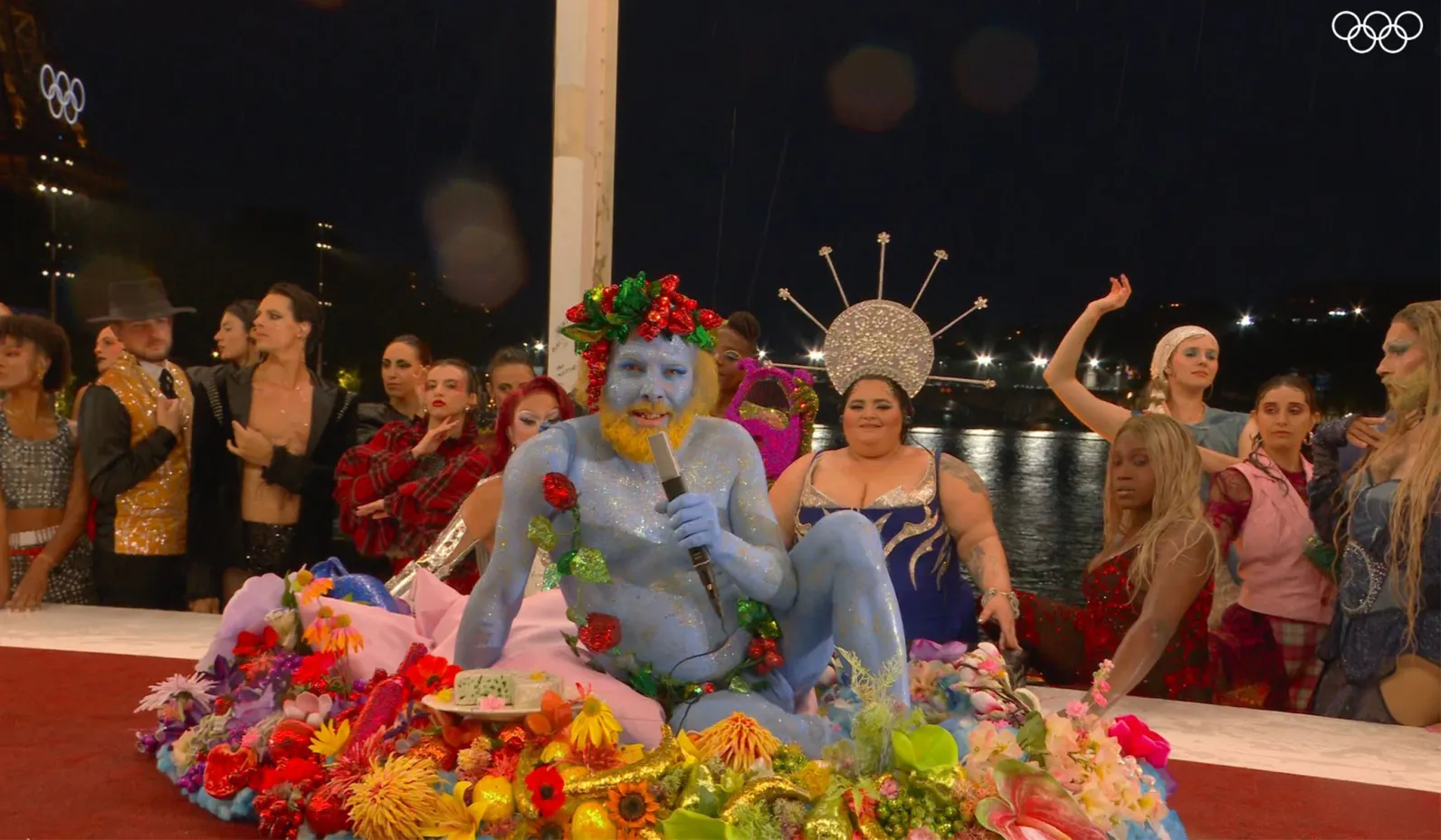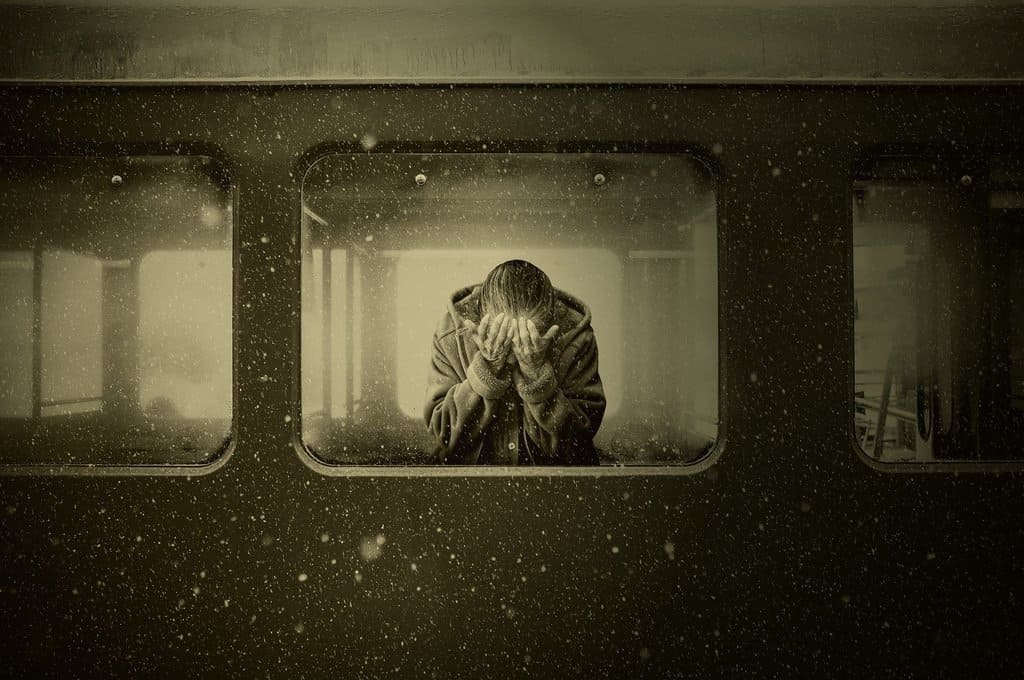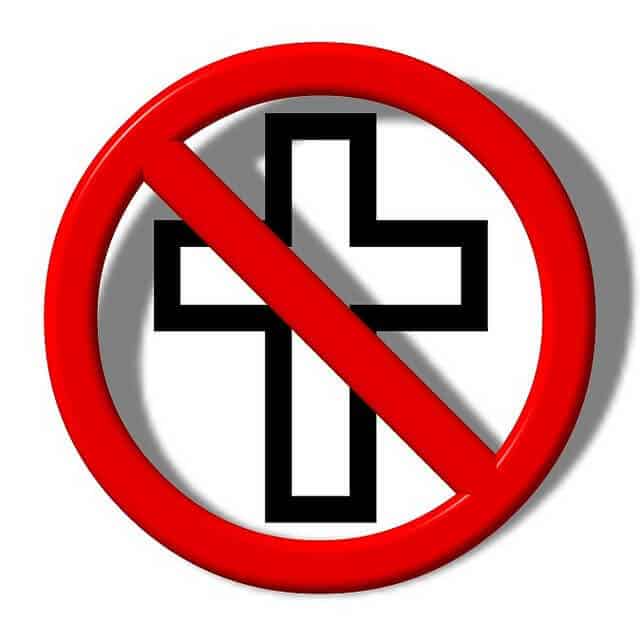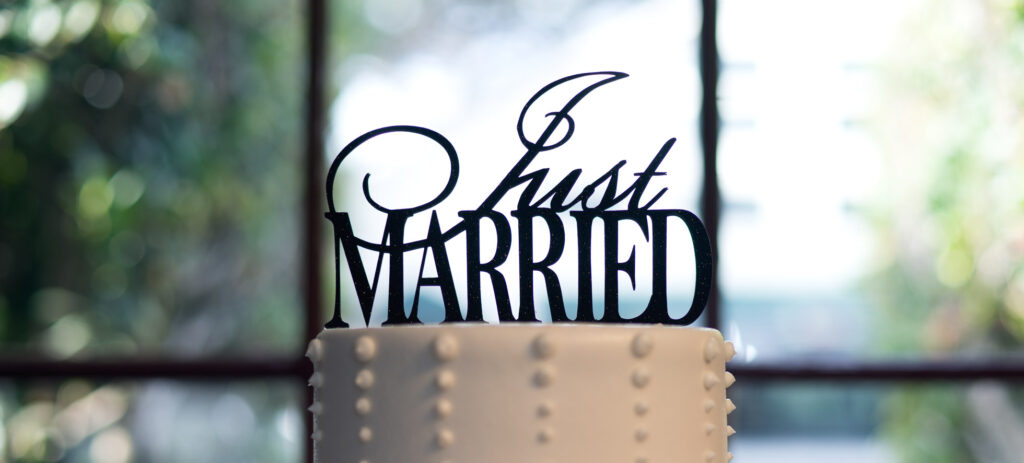I am a scholar of art & religion. This is one of those rare moments when my academic discipline intersects with a major media story. I am also a Christian, so this story is of both professional and personal interest to me. By now, you likely have heard about the opening ceremony of the Olympics making fun of Christianity. The narrative is that there was a tableau vivant that mocked Leonardo Da Vinci’s famous Last Supper painting with drag queens and trans participants.
Social media went crazy with mass condemnations of the Olympics and its purported attack on Christianity.
I did not watch the opening ceremonies. I first found out about the controversy when I was curating news articles for the Faith on View Daily newsletter. I did select an article about the controversy, not because I found it offensive but because it is the type of news that interests our readers. Beyond recognizing that some would be interested, I did not give the issue a lot of thought.
Why be Offended?
From my perspective, we should not be surprised if non-Christians do not take our religious imagery seriously. Why should I be surprised or offended that people who think my beliefs are fictional do not honor my sacred stories? If anything, I should feel sorrow that they do not know the love of Christ.
If someone mocks the idea that the earth is round, do I get upset? No. Because I have confidence that it is round and their ignorance does not offend me. It saddens me. Likewise, if I have confidence in the truth of Christ, it should not offend me that someone mocks Christ. Their lack of relationship with the Savior should break my heart. If I were enraged that someone believed the world was flat and mocked “round-earthers,” it would betray my lack of confidence in a round earth. In the same way, as Christians, we should be so confident that Christ is true that any mockery breaks our hearts rather than enrages us.
Several hours after selecting the articles for the newsletter, I started to hear the rumblings of the Christian outrage culture.
There has already been a ton written (and recorded) about this. I have seen social media posts, articles, and YouTube videos leaning into the outrage. Soon, others started responding, arguing that an ‘inclusive’ Last Supper is very Christian, and then others pointed out that the “Last Supper” was not a Last Supper.
A Cautious Approach
Given the level of outrage, I decided to spend some time researching. Additionally, I also wanted to go back and see the original broadcast. Unfortunately, this was harder to find than I thought. I was able to find the scene that articles were calling a tableau of the Last Supper. However, what was originally called a “Blue Smurf” by some but was actually a depiction of the Greek god Dionysus seems to have not been included in the American broadcast. After watching the American broadcast and reviewing clips I could find online, which were sent to me by friends, I feel like I have a decent grasp of what aired both domestically and internationally.
Now for some thoughts.
The ‘Last Supper’ Claim

The first image of the ‘tableau’ I saw was taken from X, formerly known as Twitter. This image contrasts the scene from the opening ceremony with a copy of Da Vinci’s famous painting. There is certainly a resemblance. But the more I learned, the more I began to question. This image from Paris has 12 figures, seven figures on ‘Christ’s’ right and four on the left. The Da Vinci painting, like all Last Suppers, has 13 figures, and Da Vinci placed six on each side. As I investigated, I also found that that image had been cropped. The video from which this still was taken begins with a focus on the central figures and then zooms out to reveal a total of 18 figures.
It is also curious that those who are outraged claim that the figure with the silver crown is an obese female representation of Jesus. Jesus has no halo in the Da Vinci painting. Interestingly, the first YouTube video I watched about this issue claimed that the crown on the woman was meant to reference the crown of thorns, something that is never a part of a Last Supper scene. The outraged YouTuber was looking for any possible connection but was fully ignorant of the history and imagery that he was critiquing.
Was it the Last Supper or a Bacchanalia?
Many quickly began to argue that this wasn’t even a scene of the Last Supper. They argued that it was referencing The Feast of the Gods, a painting by Jan Hermansz van Bijlert. In this interpretation, the woman with the halo was meant to reference Apollo in the painting.
There are some good arguments for this. First, it would explain the appearance of the blue Dionysus figure. Like the Last Supper’s, it also has a table. The little angel (putti) to Apollo’s right might explain the young child in the Opening Ceremony. In this painting, Apollo holds a harp. A fuschia harp was held by a figure in the opening ceremony. Those who take this position also point to the Greek roots of the Olympics and argue that this performance made that connection. Finally, the overall thrust of the Opening Ceremony was an abstract reference to French history. Leonardo’s painting is in Italy, while van Bijlert’s painting is in a French museum about 200 miles outside of Paris.

There is an inconsistency among the people who make this argument. They reference this scene as a Bacchanalia. However, the scene in this painting is not a Bacchanalia. Bacchanalia were festivals dedicated to Bacchus (Dionysus in Greek). These were human festivals filled with wine and debauchery. Further, van Bijlert is a Dutch painter, and it would seem obscure for a reference in Paris’ Olympic Opening Ceremony when there is a Bacchanal painting by the very famous French painter Nicolas Poussin in the Louvre.

So which was it?
Everyone wants to know which it was. Some are drawing hard battle lines. I even saw one pastor argue that it was both.
In his argument, he made an important point, “This confusion [about which it is] stems from asking ‘What is it made of?’ instead of ‘What does it mean?’” This is a good point, sort of. When it comes to art, many make the mistake of asking, “What does it mean?” rather than “What is it about?” Many outside the arts, and this is especially true of those in the church, live in a discursive world where all communication is subservient to analytical reasoning. Art, however, has a tendency to be far less discursive and didactic than many understand.
What is it about?
We have examined the possible art historical influences on this performance, but we should also consider what those who made it have said.
The interpretation of the Greek God Dionysus makes us aware of the absurdity of violence between human beings. #Paris2024 #OpeningCeremony pic.twitter.com/FBlQNNUmvV
— The Olympic Games (@Olympics) July 26, 2024
Before the controversy erupted, the Olympic Games ‘X’ page stated that this was an interpretation of Dionysus and that the performance was about the absurdity of violence. Some of this meaning was lost for the English-speaking audience since the performance was sung in French. Honestly, there is a question about how successful this piece is in communicating that idea. But it must be remembered that this was posted prior to the ensuing controversy, so it isn’t spin.
After the controversy, the IOC made a statement.
The IOC has taken note of and welcomes the clarification given by the Paris 2024 Organising Committee regarding the Opening Ceremony. pic.twitter.com/kEB9zyw3Ue
— IOC MEDIA (@iocmedia) July 28, 2024
There is obviously the problematic language “if anyone was offended.” But this statement reiterates a similar theme of “community and tolerance.”
Even the NBC commentator, Kelly Clarkson, referenced the goals of the performance, “I don’t know if we are going to show you all it again, but that runway… I mean, Mike and I have been talking about this. Everyone is included at this table. It doesn’t matter who you are. It represents all ages, all ethnicities, everything is represented on this runway. And I think it is so important that Paris did that. It’s very cool.” To which Mike Tirico added, “That’s the spirit of this city. Isn’t it?”
What have the Creatives said?
Thomas Jolly
Thomas Jolly was the Art Director for the Opening Ceremony and seems to have taken the process seriously. “How do you write a show in which everybody, at one point, feels represented and a part [of] this bigger thing, this bigger ‘us’? For an artist, it is a beautiful responsibility to have,” Jolly explained. “It’s ambitious but also complex because one has to broaden one’s own imagery, one’s own outlook and include everyone, understand everyone so that no one feels left behind.”
“The Last Supper” was “not my inspiration,” Jolly expressed later. “The idea was to have a pagan celebration connected to the gods of Olympus. You will never find in me a desire to mock and denigrate anyone.” This quote may be the strongest evidence linking the performance to van Bijlert’s The Feast of the Gods.
Jolly explained his vision to The Associated Press. “My wish isn’t to be subversive, nor to mock or to shock,” Jolly said. “Most of all, I wanted to send a message of love, a message of inclusion and not at all to divide.”
Phillippe Katerine
French actor and singer Phillippe Katerine, who played the role of Dionysus, did little to pacify the controversy when he said on French TV, “It wouldn’t be fun if there were no controversy. Wouldn’t it be boring if everyone agreed on this planet?” While some have taken this as admitting that the scene intentionally mocked Christianity, it doesn’t go that far and is more likely reflective of Katerine’s acceptance that there will often be controversy in art. He certainly was not remorseful about his performance, “It’s my culture,” he said. “We’re full of different people and everyone lives their own way and, above all, has the right to do so. I loved doing it.”
Barbara Butch
Barbara Butch, who is accused of playing Christ in a mocking tableau, published on her Instagram that she is a “Love activist, Dj, and producer. My aim is to unite people, gather humans & share love through music”. Unfortunately, her role in this performance has resulted in cyber-bullying, including threats of “death, torture, and rape” along with “anti-semitic, homophobic, sexist, and grossophobic insults.”
My Conclusions
If I had not first heard about the controversy before watching the segment, I am certain that it would not have even occurred to me that it was a Last Supper scene mocking Christians.
The scene starts with a tight shot of the central figures and then pans out to show 18 figures dancing. Slowly, the camera turns to reveal a runway with dancers on both sides. As the image in the CBS News tweet below shows, this is a fashion show with a red “carpet” runway and dancers on both sides.
Paris Olympics organizers say sorry for offense, but insist opening ceremony did not depict "The Last Supper." It was a scene depicting Dionysus, the Greek god of wine, based on The Feast of the Gods, a 17th century painting by Dutch artist Jan Harmensz. https://t.co/Rrdmy3LNX8
— CBS News (@CBSNews) July 29, 2024
I think the answer is that this is neither a tableau of the Last Supper, The Feast of the Gods, nor a tableau of a Bacchinal painting. I believe this performance cannot be reduced to the questions, “What is it made of?” or even “What does it mean?” It is a piece about unity and acceptance.
A fashion show is the height of moneyed culture. There are very clear “types” that are acceptable on the runway. Barbara Butch plays the role of an obese, lesbian personification of Liberty who is very different than the beautiful bare-chested Liberty made famous by Eugène Delacroix. She is surrounded by a diverse cast, from children to beautiful women to individuals in drag.
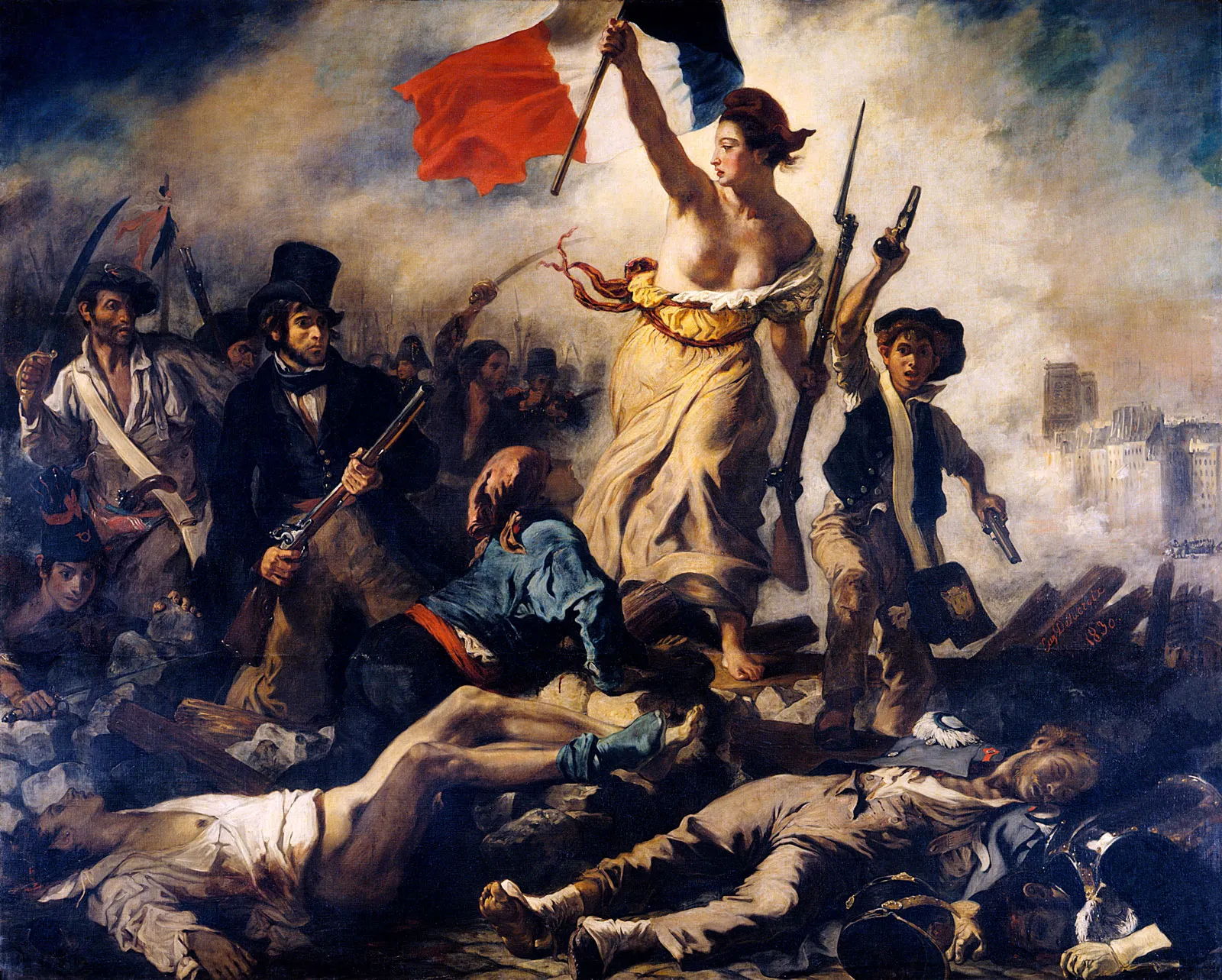
The performance on the bridge was titled Festivité, or in English, festivity, celebration, or party. It may best be seen as a celebration of unity in diversity, an idea also reflected in the lyrics of Imagine, which was performed during the Opening Ceremony.
Imagine there’s no countries
It isn’t hard to do
Nothing to kill or die for
And no religion, tooImagine all the people
Livin’ life in peaceYou may say I’m a dreamer
But I’m not the only one
I hope someday you’ll join us
And the world will be as oneImagine no possessions
I wonder if you can
No need for greed or hunger
A brotherhood of manImagine all the people
Sharing all the world
Dionysus, as the Greek god of fertility, wine, and revelry, can be seen as an appropriate link between the Greek origins of the games and celebration on a bridge in modern Paris
Whether this performance effectively addressed the issues at hand is a different matter entirely and one I am not seeking to address.
And if it were the Last Supper?
While I do not believe that the visuals or the context of the performance demand the conclusion that the tableau on the bridge was of a Last Supper, I cannot rule out entirely that it was not some part of the idea, even if subconsciously. There were plenty of allusions to the French Revolution, which had a strong anti-clerical element.
France is also a strongly secular culture. The French Revolution was a central part of the nation’s transition from a Catholic to a secular ethos. If it was their intent to replace the figure of Christ with a figure of Liberty, that would make a certain sense.
In that case, I would have to ask, “So what?” Why would that really matter? Yes, it would mean that they appropriated a Christian symbol and embued it with a secularist meaning. But Christianity has been doing that for 2,000 years. One of the successful strategies in spreading Christianity was embuing local pagan symbols with Christian meaning.
It goes back further. The Tabernacle and temple in the Old Testament are fairly standard Middle Eastern temple structures. The great difference was that God’s instructions replaced the stone, clay, or golden cult statue with the Mercy Seat, a symbol of the Invisible God who is with us. Is that not what a secularist reimagining of the Last Supper would do? Would it not replace God incarnate with the Enlightenment god, Liberty?
I do not think we as Christians should get offended when others do what we have done for millennia, what God himself did.
The Bigger Issue
There is, I believe, a much bigger issue at play.
Christ called the Church to be known by their love. Unfortunately, we are often known for our outrage. Sadly, our outrage can also point to our hypocrisy.
Well-known Christian Speaker of the House Mike Johnson was quick to make a condemnatory post about this performance.
However, I can find no record of Mike Johnson condemning the Golden Statue of Trump at the 2021 CPAC, where he was a participant.
Candace Cameron Bure also posted about this issue on her Instagram. Initially, I was sympathetic to her video as she spoke about how, more than being mad, people not knowing Christ should break our hearts. Then she went too far when she said, “Don’t get tired of sharing the Gospel. And it’s not just for the people who openly mock God… There’s Christians out there who say, I’m a Christian and it didn’t really bother me. Those people need to hear the Gospel too. It’s the ones that are lukewarm…” She then moves on to Revelation and the passage about God spitting out the lukewarm water.
It would seem that the Gospel in which Bure places her faith requires our outrage. If we consider the context and history and do not find ourselves outraged by this, we need the Gospel. This is dangerous.
Why aren’t you offended by…?
In researching this essay, I ran across the article “Why aren’t evangelicals offended by Donald Trump?”. The author, Martin Thielen, is sympathetic to the offense evangelicals are taking over the Opening Ceremonies, but he raises an important question:
What I cannot understand is this: Why aren’t evangelicals offended by Donald Trump?
By his numerous adulterous affairs? By his porn star payoffs? By his bragging about “grabbing women by the pussy”? By a jury of his peers finding him liable for sexual assault? By his rampant sexism? By his lack of character? By his lack of decency? By his endless lies? By his criminality? By his threats to democracy? By his admiration of dictators? By his mocking of disabled persons, POWs and victims of violent assault? By his frightening language about immigrants being “vermin” and people who “are poisoning our blood”? By his fearmongering? By his hatred? By his chronic anger and rage? By his politics of revenge and retribution? By his racism? By his pathological narcissism? By his lack of any evidence of Christian faith, morals or values? And the list could go on and on and on and on.
I don’t believe the evangelical world understands the massive damage they have done to the Christian cause. Their gross hypocrisy about Donald Trump (and many other things) has turned millions of people away from Christ and the church, especially young people. Christianity is in serious decline in America. One of the leading causes of that decline is the hypocrisy of the Religious Right.
This isn’t about Trump
I do not want to make this about Trump. He is not the point of this essay.
I have written before about John McNaughton, the far-right Mormon artist who is also very popular among evangelicals. He has also painted a Last Supper.

A Google search for this painting and the word “blasphemy” turns up a single result to a message board where the poster says they aren’t sure it is blasphemy and concludes with, “It’s just art, though, and not verbatim Scripture.”
The 2012 action movie The Expendables 2 had a Last Supper movie poster with the ensemble cast sitting at the table holding weapons.

The Prince of Peace and his disciples are replaced by mercenaries and a quest for vengeance. Yet Google is completely devoid of charges of blasphemy. There was no outrage.
People see that the Church is not outraged by paintings portraying political idolatry or movies where Christ is replaced by a violent mercenary who does everything but turn the other cheek.
This Tweet says a lot in this context.
The Olympics opens by desecrating The Last Supper… Jesus & His apostles replaced by an obese woman & transgenders.
— Liz Wheeler (@Liz_Wheeler) July 27, 2024
I told you this is spiritual warfare.
This was never about “tolerance & inclusion.”
These are demons who want to force you worship Satan.pic.twitter.com/4FrQIXnbFl
It is fine for McNaughton to replace the Disciples with presidents, including unfaithful adulterous ones, so long as Barack Obama is portrayed as Judas. It is also fine for Christ and the disciples to be replaced by violent, vengeful mercenaries. But to replace Jesus and the disciples with an “obese woman & transgenders” is to desecrate our faith.
Another Way
Let me suggest a different path forward:
If I… do not have love, I am a noisy gong or a clanging cymbal. And if I… do not have love, I am nothing.
Love is patient; love is kind; love is not envious or boastful or arrogant or rude. It does not insist on its own way; it is not irritable; it keeps no record of wrongs; it does not rejoice in wrongdoing but rejoices in the truth. It bears all things, believes all things, hopes all things, endures all things.
Love never ends…. we know only in part… When I was a child, I spoke like a child, I thought like a child, I reasoned like a child. When I became an adult, I put an end to childish ways. For now we see only a reflection, as in a mirror, but then we will see face to face. Now I know only in part; then I will know fully, even as I have been fully known. And now faith, hope, and love remain, these three, and the greatest of these is love. (Excerpt from 1 Corinthians 13)
[L]et us love one another, because love is from God; everyone who loves is born of God and knows God. Whoever does not love does not know God, for God is love. God’s love was revealed among us in this way: God sent his only Son into the world so that we might live through him…. Beloved, since God loved us so much, we also ought to love one another….
There is no fear in love, but perfect love casts out fear; for fear has to do with punishment, and whoever fears has not reached perfection in love. We love because he first loved us. Those who say, “I love God,” and hate a brother or sister are liars, for those who do not love a brother or sister, whom they have seen, cannot love God, whom they have not seen. (Excerpt from 1 John 4)
Amen.

